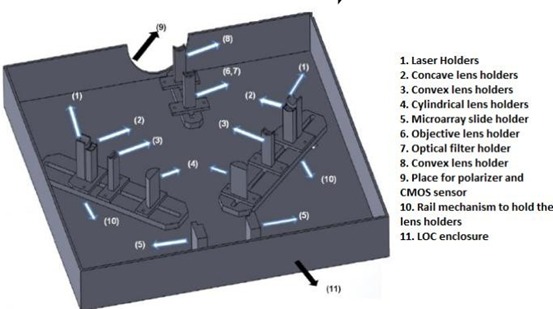The single snapshot microarray reader of the present invention comprises an illumination assembly to provide a reflected light configuration for illuminating the entire microarray substrate. The illumination assembly further comprises illumination sources to generate light beams, and one or more focusing elements relatively positioned with respect to the illumination sources for focusing the light beams such that the focused light beams simultaneously illuminate the plurality of samples arranged on the microarray substrate. The microarray reader also comprises an imaging apparatus relatively positioned with respect the illumination assembly and the microarray substrate to detect signals emitted by the microarray substrate in response to the light beams and to generate an image of the microarray substrate such that each of the plurality of samples is visualized at a desired resolution.
Traditional microarray readers typically use an X-Y scanning mechanism to image each individual spot on a biochip, which is time-consuming and limits the throughput. The conventional approach requires high-intensity lasers, complex optical setups, and often results in low experimental throughput. Additionally, the reliance on dichroic mirrors and sensitive detectors increases the cost of the system. These limitations hinder the efficient and cost-effective imaging of microarray substrates, particularly in diagnostic and research settings.
- Scan-less Imaging: The microarray reader uses a dual laser illumination system that simultaneously illuminates the entire microarray, eliminating the need for time- consuming X-Y scanning.
- Cost-Efficient Optical System: The technology utilizes simple optics, including concave lenses, convex lenses, and cylindrical lenses, instead of complex components like dichroic mirrors, reducing both the cost and complexity of the system.
- Uniform Intensity Gaussian Profile: The dual laser system ensures uniform illumination across the entire microarray, providing consistent and high-quality images.
- High-Speed Imaging: The system significantly reduces the time required to image a microarray, with the ability to acquire data in about 1 minute, compared to 3-5 minutes using conventional readers.
- Affordable: By using low-cost materials and simple optical elements, the system reduces overall manufacturing costs, making it an attractive option for low-resource settings.
- High Resolution: The system provides high-resolution imaging (e.g., 25 microns) using cost-efficient CMOS sensors.
The prototype features a dual laser illumination system with focusing elements, including concave, convex, and cylindrical lenses, designed to simultaneously illuminate the entire microarray substrate. The imaging apparatus includes a CMOS sensor to capture emitted fluorescence signals from the biochip, complemented by an optical filter to eliminate background noise and a polarizer to minimize scattering. A rail mechanism, integrated with holders, ensures precise positioning of the optical components such as lasers, lenses, and the microarray substrate. All components are housed in a compact, lightweight enclosure made from cost-efficient materials like acrylic and aluminum, optimizing both weight and cost.
The technology is at pre-clinical research, proof of concept stage.
3
The microarray reader's low cost and fast operation improve access to early disease detection in low-resource environments, enhancing healthcare outcomes. By reducing the time required to acquire microarray data, it accelerates diagnostic processes in clinical research and diagnostics. Its affordability makes it a cost-effective solution for research institutions, fostering scientific discovery. Additionally, its use of lightweight materials and energy-efficient design minimizes environmental impact.
- Medical Diagnostics: Ideal for fluorescence-based imaging of biological materials like proteins, DNA, and RNA, crucial for diagnostics in cancer research, genetic studies, and infectious diseases
- Biotechnology and Pharmaceutical Research: Useful in the development and testing of therapeutic agents, vaccines, and other biotech products
- Environmental Monitoring: Can be used for detecting pollutants and other environmental samples in microarray configurations
- Agriculture: Assisting in agricultural research for genetic analysis of crops and pests
- Food and Beverage Industry: For detecting contaminants or assessing food quality through biochip technology
Geography of IP
Type of IP
6624/CHE/2015
392530


